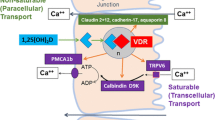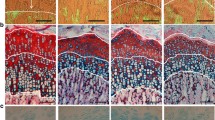Abstract
Genetic hypercalciuric stone-forming (GHS) rats, bred to maximize urine (u) calcium (Ca) excretion, demonstrate increased intestinal Ca absorption, increased bone Ca resorption, and reduced renal Ca reabsorption, all leading to elevated uCa compared to the parental Sprague–Dawley (SD) rats. GHS rats have increased numbers of vitamin D receptors (VDRs) at each site, with normal levels of 1,25(OH)2D3 (1,25D), suggesting their VDR is undersaturated with 1,25D. We have shown that 1,25D induces a greater increase in uCa in GHS than SD rats. To examine the effect of the increased VDR on the osseous response to 1,25D, we fed GHS and SD rats an ample Ca diet and injected either 1,25D [low dose (LD) 12.5 or high dose (HD) 25 ng/100 g body weight/day] or vehicle (veh) daily for 16 days. Femoral areal bone mineral density (aBMD, by DEXA) was decreased in GHS+LD and GHS+HD relative to GHS+veh, while there was no effect on SD. Vertebral aBMD was lower in GHS compared to SD and further decreased in GHS+HD. Both femoral and L6 vertebral volumetric BMD (by μCT) were lower in GHS and further reduced by HD. Histomorphometry indicated a decreased osteoclast number in GHS+HD compared to GHS+veh or SD+HD. In tibiae, GHS+HD trabecular thickness and number increased, with a 12-fold increase in osteoid volume but only a threefold increase in bone volume. Bone formation rate was decreased in GHS+HD relative to GHS+veh, confirming the mineralization defect. The loss of BMD and the mineralization defect in GHS rats contribute to increased hypercalciuria; if these effects persist, they would result in decreased bone strength, making these bones more fracture-prone. The enhanced effect of 1,25D in GHS rats indicates that the increased VDRs are biologically active.








Similar content being viewed by others
References
Bushinsky DA, Coe FL, Moe OW (2012) Nephrolithiasis. In: Brenner BM (ed) The kidney. WB Saunders, Philadelphia, pp 1455–1507
Moe OW, Bonny O (2005) Genetic hypercalciuria. J Am Soc Nephrol 16:729–745
Stechman MJ, Loh NY, Thakker RV (2007) Genetics of hypercalciuric nephrolithiasis: renal stone disease. Ann N Y Acad Sci 1116:461–484
Monico CG, Milliner DS (2012) Genetic determinants of urolithiasis. Nat Rev Nephrol 8:151–162
Bushinsky DA, Asplin JR, Grynpas MD, Evan AP, Parker WR, Alexander KM, Coe FL (2002) Calcium oxalate stone formation in genetic hypercalciuric stone-forming rats. Kidney Int 61:975–987
Bushinsky DA, Favus MJ (1988) Mechanism of hypercalciuria in genetic hypercalciuric rats: inherited defect in intestinal calcium transport. J Clin Invest 82:1585–1591
Bushinsky DA, Grynpas MD, Nilsson EL, Nakagawa Y, Coe FL (1995) Stone formation in genetic hypercalciuric rats. Kidney Int 48:1705–1713
Evan AP, Bledsoe SB, Smith SB, Bushinsky DA (2004) Calcium oxalate crystal localization and osteopontin immunostaining in genetic hypercalciuric stone-forming rats. Kidney Int 65:154–161
Grynpas M, Waldman S, Holmyard D, Bushinsky DA (2009) Genetic hypercalciuric stone-forming rats have a primary decrease in bone mineral density and strength. J Bone Miner Res 24:1420–1426
Kim M, Sessler NE, Tembe V, Favus MJ, Bushinsky DA (1993) Response of genetic hypercalciuric rats to a low calcium diet. Kidney Int 43:189–196
Krieger NS, Stathopoulos VM, Bushinsky DA (1996) Increased sensitivity to 1,25(OH)2D3 in bone from genetic hypercalciuric rats. Am J Physiol Cell Physiol 271:C130–C135
Li XQ, Tembe V, Horwitz GM, Bushinsky DA, Favus MJ (1993) Increased intestinal vitamin D receptor in genetic hypercalciuric rats: a cause of intestinal calcium hyperabsorption. J Clin Invest 91:661–667
Tsuruoka S, Bushinsky DA, Schwartz GJ (1997) Defective renal calcium reabsorption in genetic hypercalciuric rats. Kidney Int 51:1540–1547
Bushinsky DA, Willett T, Asplin JR, Culbertson C, Che SPY, Grynpas M (2011) Chlorthalidone improves vertebral bone quality in genetic hypercalciuric stone-forming rats. J Bone Miner Res 26:1904–1912
Bai S, Wang H, Shen J, Zhou R, Bushinsky DA, Favus MJ (2010) Elevated vitamin D receptor levels in genetic hypercalciuric stone-forming rats are associated with downregulation of snail. J Bone Miner Res 25:830–840
Asplin JR, Donahue SE, Lindeman C, Michalenka A, Strutz KL, Bushinsky DA (2009) Thiosulfate reduces calcium phosphate nephrolithiasis. J Am Soc Nephrol 20:1246–1253
Perry GML, Nehrke KW, Bushinsky DA, Reid R, Lewandowski KL, Hueber P, Scheinman SJ (2012) Sex modifies genetic effects on residual variance in urinary calcium excretion in rat (Rattus norvegicus). Genetics 191:1003–1013
Bushinsky DA, Michalenka AC, Strutz KL, Donahue S, Asplin JR (2007) Effect of bolus and divided feeding on urine ions and supersaturation in genetic hypercalciuric stone-forming rats. Kidney Int 73:423–429
Hoopes RR Jr, Middleton FA, Sen S, Hueber PA, Reid R, Bushinsky DA, Scheinman SJ (2006) Isolation and confirmation of a calcium excretion quantitative trait locus on chromosome 1 in genetic hypercalciuric stone-forming congenic rats. J Am Soc Nephrol 17:1292–1304
Bushinsky DA, LaPlante K, Asplin JR (2006) Effect of cinacalcet on urine calcium excretion and supersaturation in genetic hypercalciuric stone-forming rats. Kidney Int 69:1586–1592
Yao J, Karnauskas AJ, Bushinsky DA, Favus MJ (2005) Regulation of renal calcium-sensing receptor gene expression in response to 1,25(OH)2D3 in genetic hypercalciuric stone forming rats. J Am Soc Nephrol 16:1300–1308
Karnauskas AJ, van Leeuwen JP, van den Bemd GJ, Kathpalia PP, DeLuca HF, Bushinsky DA, Favus MJ (2005) Mechanism and function of high vitamin D receptor levels in genetic hypercalciuric stone-forming rats. J Bone Miner Res 20:447–454
Bushinsky DA, Asplin JR (2005) Thiazides reduce brushite, but not calcium oxalate, supersaturation and stone formation in genetic hypercalciuric stone-forming rats. J Am Soc Nephrol 16:417–424
Hoopes RR, Reid R, Sen S, Szpirer C, Dixon P, Pannet A, Thakker RV, Bushinsky DA, Scheinman SJ (2003) Quantitative trait loci for hypercalciuria in a rat model of kidney stone disease. J Am Soc Nephrol 14:1844–1850
Bushinsky DA, Grynpas MD, Asplin JR (2001) Effect of acidosis on urine supersaturation and stone formation in genetic hypercalciuric stone forming rats. Kidney Int 59:1415–1423
Bushinsky DA, Parker WR, Asplin JR (2000) Calcium phosphate supersaturation regulates stone formation in genetic hypercalciuric stone-forming rats. Kidney Int 57:550–560
Bushinsky DA, Bashir MA, Riordon DR, Nakagawa Y, Coe FL, Grynpas MD (1999) Increased dietary oxalate does not increase urinary calcium oxalate saturation in hypercalciuric rats. Kidney Int 55:602–612
Bushinsky DA, Neumann KJ, Asplin J, Krieger NS (1999) Alendronate decreases urine calcium and supersaturation in genetic hypercalciuric rats. Kidney Int 55:234–243
Yao J, Kathpalia P, Bushinsky DA, Favus MJ (1998) Hyperresponsiveness of vitamin D receptor gene expression to 1,25-dihydroxyvitamin D3: a new characteristic of genetic hypercalciuric stone-forming rats. J Clin Invest 101:2223–2232
Asplin JR, Bushinsky DA, Singharetnam W, Riordon D, Parks JH, Coe FL (1997) Relationship between supersaturation and crystal inhibition in hypercalciuric rats. Kidney Int 51:640–645
Bushinsky DA, Kim M, Sessler NE, Nakagawa Y, Coe FL (1994) Increased urinary saturation and kidney calcium content in genetic hypercalciuric rats. Kidney Int 45:58–65
Frick K, Asplin J, Favus M, Culbertson C, Krieger N, Bushinsky D (2013) Increased biological response to 1,25(OH)2D3 in genetic hypercalciuric stone-forming rats. Am J Physiol Renal Physiol 304:F718–F726
Frick KK, Bushinsky DA (2003) Molecular mechanisms of primary hypercalciuria. J Am Soc Nephrol 14:1082–1095
Adams ND, Gray RW, Lemann JJ (1982) Effects of calcitriol administration on calcium metabolism in healthy men. Kidney Int 21:90–97
Maierhofer WJ, Gray RW, Cheung HS, Lemann J Jr (1983) Bone resorption stimulated by elevated serum 1,25-(OH)2-vitamin D3 concentrations in healthy men. Kidney Int 24:555–560
Hoenderop JGJ, Nilius B, Bindels RJM (2005) Calcium absorption across epithelia. Physiol Rev 85:373–422
Bindels RJM, Hartog A, Timmermans J, Van Os CH (1991) Active Ca2+ transport in primary cultures of rabbit kidney CCD: stimulation by 1,25-dihydroxyvitamin D3 and PTH. Am J Physiol Renal Physiol 261:F799–F807
Bataille P, Bouillion R, Fournier A, Renaud H, Gueris J, Idrissi A (1987) Increased plasma concentrations of total and free 1,25(OH)2D3 in calcium stone formers with idiopathic hypercalciuria. Contrib Nephrol 58:137–142
Broadus AE, Horst RL, Lang R, Littledike ET, Rasmussen H (1980) The importance of circulating 1,25(OH)2D in the pathogenesis of hypercalciuria and renal stone formation in primary hyperparathyroidism. N Engl J Med 302:421–426
Insogna KL, Broadus AE, Dryer BE, Ellison AF, Gertner JM (1985) Elevated production rate of 1,25-dihydroxyvitamin D in patients with absorptive hypercalciuria. J Clin Endocrinol Metab 61:490–495
Shen FH, Baylink DJ, Nielsen RL (1975) Increased serum 1,25-dihydroxy cholecalciferol (1,25 diOHD3) in patients with idiopathic hypercalciuria (IH). Clin Res 23:423A
Zerwekh JE, Reed BY, Heller HJ, Gonzalez GB, Haussler MR, Pak CY (1998) Normal vitamin D receptor concentration and responsiveness to 1,25-dihydroxyvitamin D3 in skin fibroblasts from patients with absorptive hypercalciuria. Miner Electrolyte Metab 24:307–313
Favus MJ, Karnauskas AJ, Parks JH, Coe FL (2004) Peripheral blood monocyte vitamin D receptor levels are elevated in patients with idiopathic hypercalciuria. J Clin Endocrinol Metab 89:4937–4943
Bouxsein ML, Boyd SK, Christiansen BA, Guldberg RE, Jepsen KJ, Muller R (2010) Guidelines for assessment of bone microstructure in rodents using micro-computed tomography. J Bone Miner Res 25:1468–1486
Parfitt AM, Glorieux FH, Kanis JA, Malluche H, Meunier PJ, Ott SM, Reker RR (1987) Bone histomorphometry nomenclature, symbols and units. Bone Miner Res 2:595–610
Dempster DW, Compston JE, Drezner MK, Glorieux FH, Kanis JA, Malluche H, Meunier PJ, Ott SM, Recker RR, Parfitt AM (2013) Standardized nomenclature, symbols, and units for bone histomorphometry: a 2012 update of the report of the ASBMR Histomorphometry Nomenclature Committee. J Bone Miner Res 28:2–17
Lieben L, Masuyama R, Torrekens S, Van Looveren R, Schrooten J, Baatsen P, Lafage-Proust M-H, Dresselaers T, Feng JQ, Bonewald LF, Meyer MB, Pike JW, Bouillon R, Carmeliet G (2012) Normocalcemia is maintained in mice under conditions of calcium malabsorption by vitamin D-induced inhibition of bone mineralization. J Clin Invest 122:1803–1815
Krieger NS, Hefley TJ (1989) Differential effects of parathyroid hormone on protein phosphorylation in two osteoblast-like cell populations isolated from neonatal mouse calvaria. Calcif Tissue Int 44:192–199
Baldock PA, Thomas GP, Hodge JM, Baker SU, Dressel U, O’Loughlin PD, Nicholson GC, Briffa KH, Eisman JA, Gardiner EM (2006) Vitamin D action and regulation of bone remodeling: suppression of osteoclastogenesis by the mature osteoblast. J Bone Miner Res 21:1618–1626
Parfitt AM (1990) Osteomalacia and related disorders. In: Aviolo L, Krane S (eds) Metabolic bone disease. Saunders, Philadelphia, pp 329–396
Acknowledgments
This work was supported in part by grant RO1 DK075462 from the National Institutes of Health. We thank Tiffany Ho for excellent technical assistance.
Author information
Authors and Affiliations
Corresponding author
Additional information
The authors have stated that they have no conflicts of interest.
Rights and permissions
About this article
Cite this article
Ng, A.H., Frick, K.K., Krieger, N.S. et al. 1,25(OH)2D3 Induces a Mineralization Defect and Loss of Bone Mineral Density in Genetic Hypercalciuric Stone-Forming Rats. Calcif Tissue Int 94, 531–543 (2014). https://doi.org/10.1007/s00223-014-9838-7
Received:
Accepted:
Published:
Issue Date:
DOI: https://doi.org/10.1007/s00223-014-9838-7




